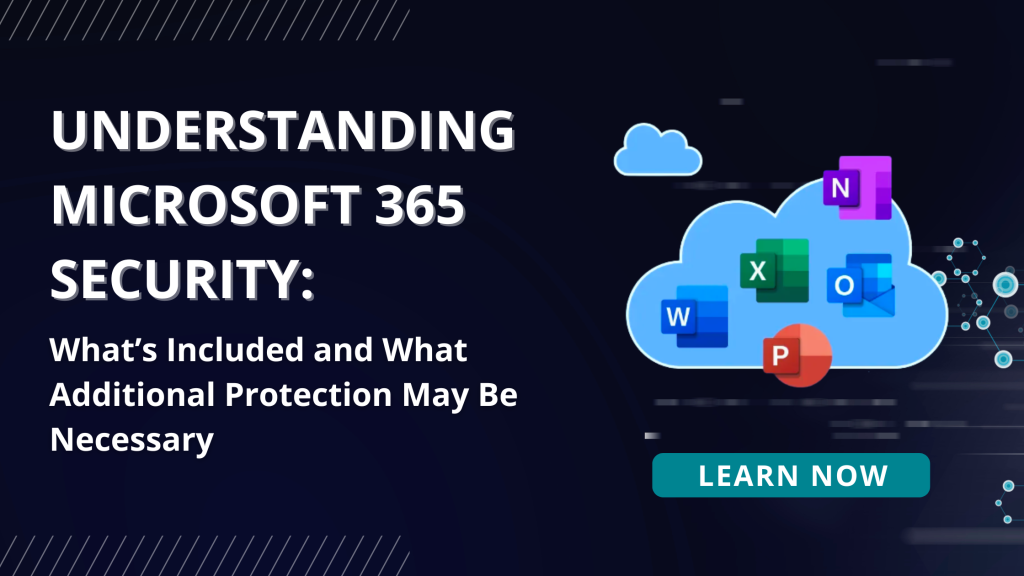Microsoft 365 has become an important tool for businesses, it offers services such as email, file storage, and collaboration. While Microsoft includes several built-in security features to protect data, the main question remains: Are these measures enough? As cyber threats continue to evolve, businesses must assess whether these protections are good enough for safeguarding against sophisticated attacks.
In this blog post, we will review Microsoft’s built-in security features, where these may fall short, and why added tools might be necessary. Microsoft 365 offers a solid foundation for security, but extra layers of protection may be needed depending on your specific needs.

Microsoft 365’s Security Features
Microsoft 365 offers a few security tools, which vary depending on the plan you choose. These tools help protect your data and ensure that your environment stays secure:
-
Microsoft Defender for Office 365:
This program guards against dangers in your apps and emails. It looks for malware, phishing scams, and other harmful things in your emails and apps. The goal of features like Safe Attachments and Safe Links is to stop users from accidentally downloading dangerous files or clicking on dangerous links.
-
Encryption:
Your data is encrypted by Microsoft 365 when it is in transit (transmitted over a network) and at rest (stored on Microsoft’s servers), Also even after sensitive files have been shared outside, Rights Management Services (RMS) provide an added degree of security.
-
Data Loss Prevention (DLP):
DLP helps prevent the accidental sharing of sensitive information, such as financial data or personal identifiers. By setting up rules, businesses can block or alert users when such data is being shared inappropriately.
-
Multi-Factor Authentication (MFA):
By needing more than just a password to access your account, MFA adds another layer of protection. The possibility of unwanted access is greatly decreased by a second element, such as a one-time code texted to a mobile device.
-
Conditional Access Policies:
These allow companies to set up guidelines according to criteria, like the device or location from which a user is logging in. This guarantees that sensitive data can only be accessed by devices and individuals that are trusted.
-
Compliance Manager:
Compliance Manager is a useful tool for businesses in regulated industries. It helps track and manage compliance with regulations such as GDPR, HIPAA, and others, ensuring that your organization adheres to required standards.
-
Azure Active Directory (Azure AD):
Azure AD is a cloud-based identity management system that helps businesses manage user authentication and prevent unauthorized access to critical resources within Microsoft 365.
Where Microsoft 365 Security May Fall Short
While Microsoft 365 provides a strong foundation of security, it is important to acknowledge that no single platform can provide complete protection. As cyberattacks become more complex, businesses may need to get more added solutions to address any gaps in security.
-
Advanced Threat Protection (ATP):
Microsoft Defender provides solid protection, but it may not detect new, emerging threats, particularly zero-day attacks. Solutions like SIEM tools (Security Information and Event Management) or Endpoint Detection and Response (EDR) platforms can provide more advanced protection by monitoring user behaviour, analysing threats in real-time, and finding patterns of malicious activity.
-
SIEM Solutions for Comprehensive Monitoring:
While Microsoft 365 offers some monitoring capabilities, it lacks a full SIEM solution that can provide enterprise-wide visibility. Third-party SIEM tools offer more comprehensive monitoring, better correlation of security events, and integration with non-Microsoft systems.
-
User Behaviour Analytics (UBA):
While Microsoft 365 includes basic user activity monitoring, it may not be enough to detect insider threats or account compromise. UBA tools offer deeper insights into user behaviour, enabling businesses to find abnormal activities and potential risks before they escalate into serious security incidents.
-
Advanced Endpoint Security:
Although Microsoft Defender for Endpoint provides robust defence, companies may want additional solutions for more sophisticated capabilities like attack surface reduction, thorough forensics, and proactive threat hunting.
-
Backup and Disaster Recovery:
Although OneDrive and SharePoint in Microsoft 365 provide basic backup features, companies may require more powerful options to guarantee thorough disaster recovery, especially in the event of ransomware or major data loss. Version histories, cross-cloud disaster recovery, and automatic backups are all possible with third-party backup systems.
Why Additional Security Tools Are Needed
Even with Microsoft 365’s robust security features, third-party technologies are required to close security gaps and add an additional degree of protection. These technologies offer richer reporting, more thorough monitoring across several settings, and the ability to handle sophisticated threats that Microsoft’s built-in functions might overlook.
How to Assess Your Security Needs
To decide whether added security tools are needed, businesses should assess their current security posture by considering the following:
- Find Your Security Concerns: Regularly assess your organization’s security risks. What type of data do you store? What are your key vulnerabilities? If you manage sensitive data or have experienced security issues in the past, added protection may be necessary.
- Evaluate Compliance Requirements: make sure that your security measures meet industry-specific regulations. If Microsoft 365’s built-in compliance tools fall short, consider added solutions that specialize in these areas.
- Conduct a Security Audit: Periodically review your security infrastructure. Evaluate Microsoft 365’s built-in features, endpoint protection, backup solutions, and threat detection systems to find potential weaknesses.
- Monitor Activity Continuously: Regularly check your Microsoft 365 environment for unusual activity. If you notice potential security gaps or find that you cannot respond quickly enough to appearing threats, consider adding SIEM or EDR solutions.
A good place to start when it comes to company security is with Microsoft 365. However, it’s crucial to add extra security layers to completely shield your company from changing threats. Comprehensive monitoring tools, reliable backup options, and advanced threat detection can strengthen your defences and offer a higher degree of security. Assess your security requirements on a regular basis to make sure you are ready to protect your company from possible threats.




